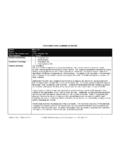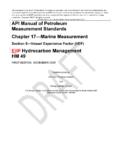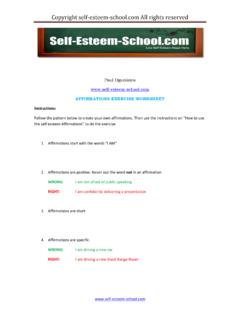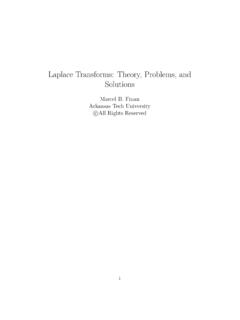Transcription of All rights reserved 2 - Ken Szulczyk
1 1 2 Money, Banking, and International Finance Copyright 2010 by Kenneth R. Szulczyk All rights reserved Cover design by Kenneth R. Szulczyk Edition 2, February 2014 3 Table of Contents TABLE OF CONTENTS .. 3 PREFACE .. 9 1. MONEY AND THE FINANCIAL SYSTEM .. 10 Financial Markets .. 10 Central Banks .. 11 Barter and Functions of Money .. 13 Forms of Money .. 15 Bitcoins .. 17 Money Supply Definitions .. 19 Key Terms .. 21 Chapter Questions .. 21 2. OVERVIEW OF THE FINANCIAL SYSTEM .. 23 Financial Intermediation .. 23 Financial Instruments .. 26 The United States Banking System .. 28 The Glass Steagall Banking Act .. 30 Financial Innovation .. 32 Websites .. 34 Key Terms .. 34 The Common Financial Instruments .. 35 Chapter Questions .. 35 3. MULTINATIONAL ENTERPRISES .. 37 Forms of Business Organizations .. 37 Corporations .. 38 Corporate Fraud .. 41 Expanding into Foreign Countries.
2 43 The Law of Comparative Advantage .. 45 Key Terms .. 47 Chapter Questions .. 48 4. INTERNATIONAL BANKS .. 49 Functions of International Banks .. 49 Kenneth R. Szulczyk 4 Becoming an International Bank .. 50 Exchange Rate Risk .. 51 International Financial Securities .. 53 Regulatory Oversight .. 55 Key Terms .. 57 Chapter Questions .. 57 5. FINANCIAL 59 Securities Market Institutions .. 59 Investment Institutions .. 62 Contractual Saving .. 63 Depository Institutions .. 66 Government Financial Institutions .. 67 Key Terms .. 68 Chapter Questions .. 68 6. FINANCIAL STATEMENTS AND THE VALUE OF MONEY .. 70 The Financial Statements .. 70 Single Investment .. 75 Multiple Investments .. 77 Compounding Frequency .. 78 Annuities and Mortgages .. 80 Foreign Investments .. 83 Key Terms .. 85 Chapter Questions .. 85 7. VALUATION OF STOCKS AND BONDS .. 87 Overview of Bonds .. 87 The Valuation of Bonds .. 88 Yield to Maturity and Rate of Return.
3 92 The Valuation of Stocks .. 94 Key Terms .. 98 Chapter Questions .. 98 8. DETERMINING THE MARKET INTEREST RATES .. 100 The Supply and Demand for Bonds .. 100 Interest Rates and the Business Cycle .. 106 The Fisher Effect .. 107 Bond Prices in an Open Economy .. 109 Money, Banking, and International Finance 5 Key Terms .. 110 Chapter Questions .. 111 9. RISK AND TERM STRUCTURE OF INTEREST RATES .. 112 Default Risk and Bond 112 Liquidity and Bond Prices .. 113 Information Costs and Bond Prices .. 114 Taxes and Bond Prices .. 115 Term Structure of Interest Rates .. 115 Key Terms .. 119 Chapter Questions .. 119 10. THE BANKING BUSINESS .. 120 A Bank s Balance Sheet .. 120 A Bank 123 The Interest Rate Risk .. 127 Securitization and the 2008 Financial Crisis .. 129 Key Terms .. 131 Chapter Questions .. 131 11. THE MONEY SUPPLY PROCESS .. 133 The Fed s Balance Sheet .. 133 Multiple Deposit Expansion and Contraction.
4 135 The Money Supply Multipliers .. 139 Key Terms .. 143 Chapter Questions .. 143 12. THE FED S BALANCE 145 The Fed s Balance Sheet .. 145 The Check Clearing 147 Changes in the Monetary Base .. 149 Does Treasury Affect the Monetary Base? .. 150 A Central Bank Intervenes with its Currency Exchange Rate .. 153 Key Terms .. 155 Chapter Questions .. 155 13. THE CENTRAL BANKS OF EUROPE AND THE UNITED STATES .. 157 Why the Government Created Federal Reserve System .. 157 The Federal Reserve System s Structure .. 158 Kenneth R. Szulczyk 6 The European Central Bank .. 160 Is the Federal Reserve Independent of the Government? .. 162 Key Terms .. 164 Chapter Questions .. 164 14. MONETARY POLICY TOOLS .. 166 Open-Market Operations .. 166 Federal Open Market Committee .. 168 Discount 169 Reserve 172 Monetary Policy 174 Time Lags and Targets .. 175 Key Terms .. 177 Chapter Questions .. 178 15. THE INTERNATIONAL FINANCIAL SYSTEM.
5 180 Balance of Payments .. 180 The Exchange Rate Regimes .. 183 Financing Balance-of-Payments Deficits and Surpluses .. 188 Hegemony .. 191 Key Terms .. 192 Chapter Questions .. 192 16. THE FOREIGN-CURRENCY EXCHANGE RATE MARKETS .. 194 Foreign Exchange Rates .. 194 Demand and Supply for Foreign Currencies .. 196 Factors that Shift Demand and Supply Functions .. 199 Fixed Exchange Rates .. 202 Key Terms .. 205 Chapter Questions .. 205 17. INTERNATIONAL PARITY CONDITIONS .. 207 A Random Walk .. 207 Purchasing Power Parity (PPP) Theory .. 208 Quantity Theory of Money .. 213 International Fisher Effect .. 214 Interest Rate Parity Theorem .. 217 Key Terms .. 221 Chapter Questions .. 221 Money, Banking, and International Finance 7 18. DERIVATIVE SECURITIES AND DERIVATIVE MARKETS .. 223 Forward and Spot Transactions .. 223 Futures and Forward Contracts .. 224 Options Contract .. 227 Special Derivatives .. 231 Evaluating Currency Swaps.
6 234 Key Terms .. 235 Chapter Questions .. 236 19. TRANSACTION AND ECONOMIC EXPOSURES .. 238 Exposure Types .. 238 Measuring and Protecting against Transaction Exposure .. 239 Measuring and Protecting against Economic Exposure .. 246 Key Terms .. 249 Chapter Questions .. 249 20. POLITICAL, COUNTRY, AND GLOBAL SPECIFIC RISKS .. 251 Political, Country, and Global Specific Risks .. 251 Measuring Country Risk .. 257 International Credit Rating 260 Key Terms .. 261 Chapter Questions .. 263 ANSWERS TO CHAPTER QUESTIONS .. 264 Answers to Chapter 1 Questions .. 264 Answers to Chapter 2 Questions .. 265 Answers to Chapter 3 Questions .. 267 Answers to Chapter 4 Questions .. 268 Answers to Chapter 5 Questions .. 269 Answers to Chapter 6 Questions .. 270 Answers to Chapter 7 Questions .. 272 Answers to Chapter 8 Questions .. 273 Answers to Chapter 9 Questions .. 274 Answers to Chapter 10 275 Answers to Chapter 11 276 Answers to Chapter 12 277 Answers to Chapter 13 278 Answers to Chapter 14 279 Answers to Chapter 15 281 Kenneth R.
7 Szulczyk 8 Answers to Chapter 16 282 Answers to Chapter 17 284 Answers to Chapter 18 285 Answers to Chapter 19 287 Answers to Chapter 20 288 REFERENCES .. 290 9 Preface I taught Money & Banking and International Finance several times, and I converted my lecture notes into a textbook. Consequently, instructors can use this textbook for courses in Money & Banking, or International Finance or some hybrid in between them. Furthermore, financial analysts and economists could refer to this book as a study guide because this book contains concise information, and all facts and analysis are straight to the point, explaining how governments and central banks influence the exchange rates, the interest rates, and currency flows. The Financial Crisis severely impacted the world s financial markets that are still felt in 2014. I included many examples from the 2008 Financial Crisis, when many banks and financial institutions teetered on bankruptcy.
8 Unfortunately, the financial crisis has not ended, and it continues affecting the world s economies and financial markets. 10 1. Money and the Financial System This chapter introduces the financial system. Students will learn the purpose of financial markets and its relationship to financial institutions. Financial institutions connect the savers to the borrowers through financial intermediation. At the heart of every financial system lies a central bank. It controls a nation s money, and the money supply is a vital component of the economy. Unfortunately, economists have trouble in defining money because people can convert many financial instruments into money. Thus, central banks use several definitions to measure the money supply. Furthermore, if an economy did not use money, then people would resort to an inefficient system barter. Unfortunately, this society would produce a limited number of goods and services.
9 Nevertheless, money overcomes the inherent problems with a barter system and allows specialization to occur at many levels. Financial Markets Money and the financial system are intertwined and cannot be separated. They both influence and affect the whole economy, such as the inflation rate, business cycles, and interest rates. Consequently, consumers, investors, savers, and government officials would make better-informed decisions if they understood how the financial markets and money supply influence the economy. A financial market brings buyers and sellers face to face to buy and sell bonds, stocks, and other financial instruments. Buyers of financial securities invest their savings, while sellers of financial securities borrow funds. A financial market could occupy a physical location like the New York Stock Exchange where buyers and sellers come face-to-face, or a market could be like NASDAQ where computer networks connect buyers and sellers together.
10 A financial institution links the savers and borrowers with the most common being commercial banks. For example, if you deposited $100 into your savings account, subsequently, the bank could lend this $100 to a borrower. Then the borrower pays interest to the bank. In turn, the bank would pay interest to you for using your funds. Bank s profits reflect the difference between the interest rate charged to the borrower and the interest rate the bank pays to you for your savings account. Why would someone deposit money at a bank instead of directly buying securities through the financial markets? A bank, being a financial institution, provides three benefits to the depositor. First, a bank collects information about borrowers and lends to borrowers with a low chance of defaulting on their loans. Thus, a bank s specialty is to rate its borrowers. Second, the bank reduces your investment risk.






